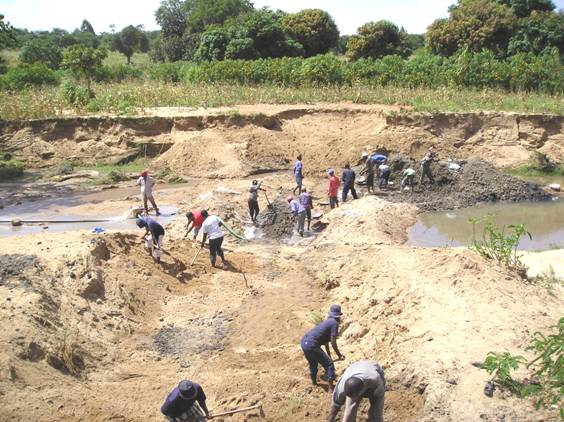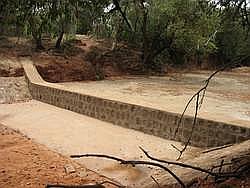Difference between revisions of "Subsurface harvesting systems"
(→Field experiences) |
|||
| Line 76: | Line 76: | ||
==Field experiences== | ==Field experiences== | ||
| − | A subsurface reservoir in Pernambuco, Brazil has an average depth of 4m, is 50m wide, and 500m long, storing about 4,000m3 of water. | + | * A subsurface reservoir in Pernambuco, Brazil has an average depth of 4m, is 50m wide, and 500m long, storing about 4,000m3 of water. |
| + | <br> | ||
{|style="width: 70%; text-align: justify; background-color: #f5f5f5;" | {|style="width: 70%; text-align: justify; background-color: #f5f5f5;" | ||
|[[Image:rsr 393.jpg|thumb|none|200px|<font size="2"><center>Project 393</center></font>|link=http://www.akvo.org/rsr/project/393/]] | |[[Image:rsr 393.jpg|thumb|none|200px|<font size="2"><center>Project 393</center></font>|link=http://www.akvo.org/rsr/project/393/]] | ||
Revision as of 00:50, 21 August 2013

The use of subsurface dams in naturally occurring alluvium creates groundwater storage upstream of the dam, raising the water table and preventing evaporation losses. These are structures that reduce or stop the flow of shallow groundwater. A subsurface dam is constructed across a valley in a seasonally dry, sandy riverbed, by digging a trench down to the bedrock or other impervious layer (clay) at the base of the river. The dam, which is placed in the trench, may consist of a wall or screen and covered with excavated material until it is completely concealed. The refill material must be properly compacted. There are two types of groundwater dams: a subsurface dam (which is explained here) and a sand dam. A subsurface dam is the easier one to build of the two. The structure is built inside an existing riverbed, so that after a flooding event, for example, water is increased due to a new and higher water level within the sand.
Suitable conditions
- Siting requirements are similar to the sand dam.
- Subsurface dams should be built where sand volume is already sufficient to store water.
- Seasonal rivers in semi-arid regions with permeable sediments and an impervious layer at a shallow depth (maximum 3 to 4m deep).
- River valleys with gradients of between 1 and 2% usually enable the highest storage.
- Ideal where groundwater flow converges from a large catchment into a narrow passage.
| Advantages | Disadvantages |
|---|---|
| - Subsurface dams are not likely to deteriorate, with little danger of breaching - Losses from evaporation are very much less than the 2.0 metres lost annually from a free water surface in a dry tropical area |
- Leakage is often difficult to detect - Water losses may occur through cracks in the impermeable layer (it may be possible to drill a well in the fracture zone and utilize the dam as an artificial recharge structure) |
Resilience to changes in the environment
Drought
Effects of drought: Can dry up.
Underlying causes of effects: Less recharge of aquifer due to less rainfall; Increasing population & water demand; Size of aquifers – e.g. limited sand volume; Too much silt accumulates behind dam; Wells not sunk deep enough into water table; Incorrect siting causes leaking dams.
To increase resiliency of WASH system: Competent siting & construction; Build sand dam in stages to reduce silt; Soil & water conservation techniques in upper part of catchment; Dig abstraction wells/pipes deeper.
More information on managing drought: Resilient WASH systems in drought-prone areas.
Construction, operations and maintenance
General advice on cement: A common cause of cracks in structures and linings (e.g. in tanks, dams, waterways, wells) is errors in mixing and applying the cement. First of all, it is important that only pure ingredients are used: clean water, clean sand, clean rocks. The materials have to be mixed very thoroughly. Secondly, the amount of water during mixing needs to minimal: the concrete or cement needs to be just workable, on the dry side even, and not fluid. Thirdly, it is essential that during curing the cement or concrete is kept moist at all times, for at least a week. Structures should be covered with plastic, large leaves or other materials during the curing period, and kept wet regularly.
Specific advice:
The dam can be constructed of concrete, masonry, blockwork, stone-filled gabions with waterproof membranes such as plastic sheet or clay layer, or stabilised soil.
- Build the crest of the underground dam at least 1 metre beneath the ground surface, so the land does not become water-logged.
- Subsurface dams should have wing walls, just like a sand dam does, where you can pile up rocks so that erosion does not occur.
- Water can be abstracted by a well a short distance upstream of the dam, or by a drain system which collects water from the upstream base of the dam and leads it to the downstream side to a well or gravity-pipe system.
- Where possible, a flushing valve is installed to facilitate cleaning of the subsurface reservoir.
- To prevent seepage through the dam, plastic canvas can be used. Plastering mud and water on the downstream side of a trench is recommended to smooth the slope cut and to prevent sharp stones and roots from puncturing the fabric.
Maintenance
- The well or gravity pipe should be regularly cleaned.
- After each large flood, any damage to the dam should be repaired and the dam protected with large stones if necessary.
- For big repairs, such as when a dam has been undermined by infiltration, or damaged by a flood, many people and heavy machinery may be needed, and specialist technicians should be consulted.
- If the groundwater shows increased salinity during the dry season, a discharge pipe could be placed at the bottom of the dam, to allow annual drainage of dissolved salts.
Maintenance can normally be carried out by the users of the system or by a caretaker or watchman. Larger repairs may require skilled labour, which can usually be provided by local craftsmen. In some cases, unskilled labour may be required on a large scale (e.g. for repairing a leaking subsurface dam). The labour may be provided by the users (with or without pay), or by other people who are hired for the purpose.
Users may need to establish a local committee to manage issues, such as controlling or supervising water use, preventing water contamination, carrying out O&M activities, financing O&M, and monitoring how much stored water is still available (a piezometer or auger hole may be installed to allow a caretaker or watchman to estimate how much water is left and decide if rationing has to be introduced). Proper management may also help to prevent social conflict. For O&M tasks at the dam site, a person who lives or farms near this site could be appointed. This person could also be responsible for water alloca- tion and be involved in monitoring activities, if users obtain the water near to, or at, the site. His or her authority should be clear and accepted by all users.
Costs
Initial costs: A 3500 m3 dam costs US$2.40/m3 in Kenya and US$3.90/m3 in Tanzania.
General costs:
- Materials costs and construction: US$1,400
- Feasibility study: US$200
- Technical support: US$275
- Operation and maintenance: low
Field experiences
- A subsurface reservoir in Pernambuco, Brazil has an average depth of 4m, is 50m wide, and 500m long, storing about 4,000m3 of water.
| AKVO RSR Project: Dawa Eresa Subsurface and Sand Dam project
This project aims to provide the people in Konda and Kora with access to water. Currently the water source they use is of poor quality without year-round access. By constructing a sand dam and subsurface dam that harvest rainwater, the people will gain year-round access to water of better quality. This will reduce the time spent on collecting water and thus free time for school enrollment for children and other activities for women. |
Manuals, videos, and links
- Technology Notes: Subsurface Dams. Water Aid.
- Chapter 6: Community Water Projects. Scroll down to the section, 6.2 Subsurface Dams. Waterforaridland.com.
Acknowledgements
- Brikke, François, and Bredero, Maarten. Linking technology choice with operation and maintenance in the context of community water supply and sanitation: A reference document for planners and project staff or (alternative link). World Health Organization and IRC Water and Sanitation Centre. Geneva, Switzerland 2003.
- Smart Water Harvesting Solutions: Examples of innovative, low cost technologies for rain, fog, and runoff water and groundwater. (or alternative link) Netherlands Water Partnership, Aqua for All, Agromisa, et al. 2007.
- CARE Nederland, Desk Study: Resilient WASH systems in drought-prone areas. October 2010.



